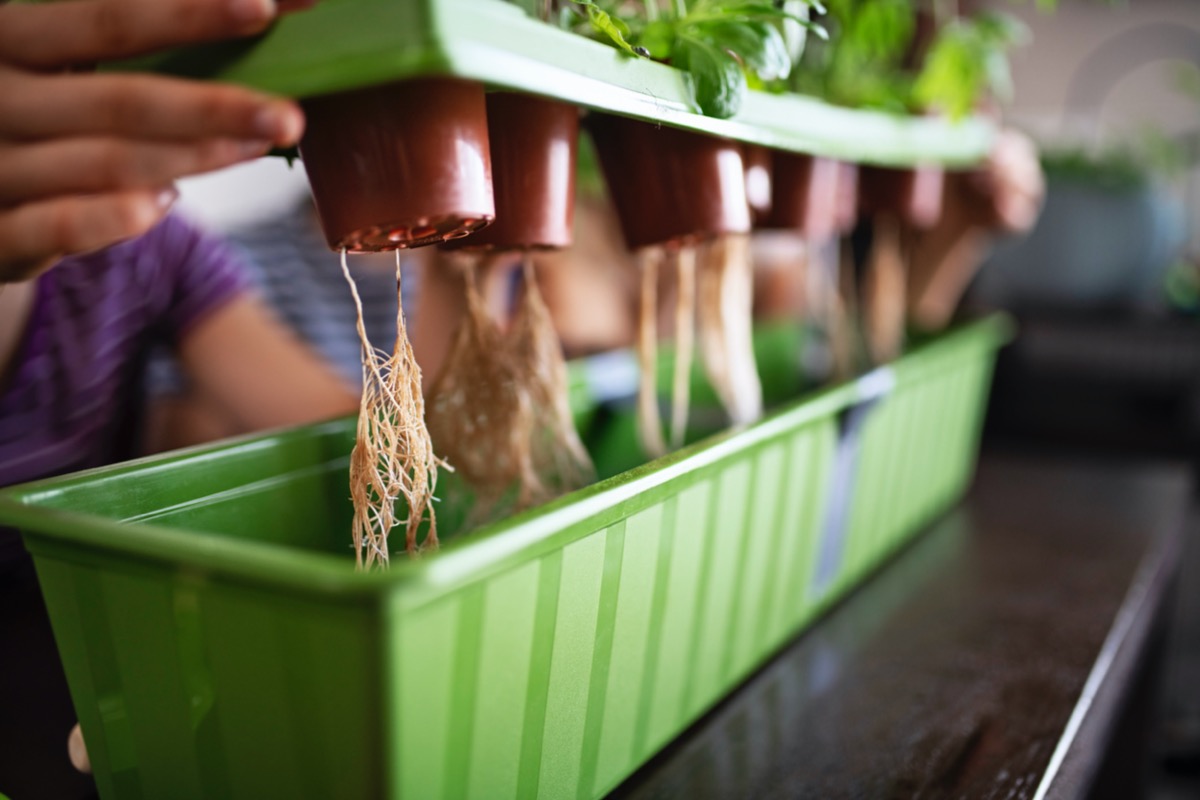

We may earn revenue from the products available on this page and participate in affiliate programs. Learn More ›
If you’ve ever taken a stem cutting from a plant and stuck it in a glass of water to grow roots, you’ve taken advantage of hydroponics. The term “hydroponics” comes from the words “water” and “labor,” and it describes a method of growing plants in a soil-free, nutrient-rich water solution.
An increasing number of fruits and vegetables found in grocery stores are produced hydroponically, but this soilless method of propagation isn’t limited to commercial growers. Indeed, homeowners are taking advantage of smaller-scale DIY hydroponics to cultivate delicious herbs, fruits, and vegetables—even during winter.
Hydroponics have been around for more than 2,000 years.
Cultivating plants in a watery environment isn’t a new idea. The Hanging Gardens of Babylon are thought to have been a crude predecessor to today’s hydroponics, including the proliferation of DIY hydroponics. It wasn’t until the 1930s, however, that scientists began experimenting with the process on a greater scale for food production.
Today, the use of hydroponics for growing vegetables and fruits is widespread; self-contained hydroponic systems appear in submarines, offshore drilling rigs, space stations, and on produce farms in almost every nation. Hydroponics offers high yields in a fraction of the space required by traditional farming, making it an attractive and innovative method for an indoor kitchen garden and a vital method for ensuring worldwide food security. It’s also quickly becoming a popular way for homeowners to grow their own fresh produce.
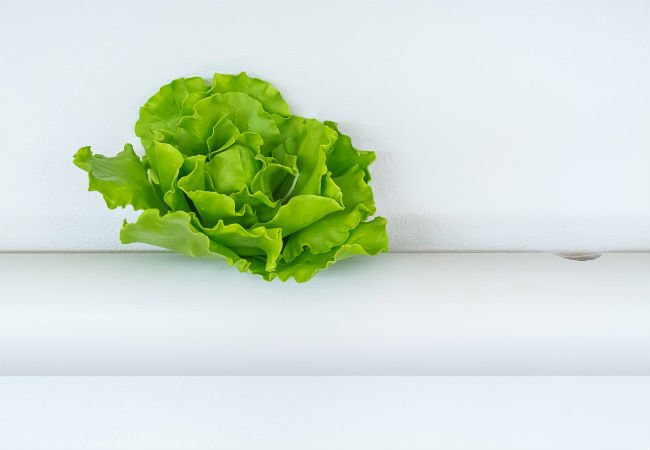
All you need for your hydroponic setup is water, light, and an inert growing medium.
In a hydroponic system, plants are grown in a sterile growing medium, such as Rockwool, coconut fiber, perlite, or sand. Unlike soil, the growing medium is inert, meaning it doesn’t contain any minerals, nutrients, or chemicals that will affect the plants.
Lightweight plastic net pots are frequently used to contain the growing medium and the plants. The net pots are then put into larger sealed enclosures where they receive water.
RELATED: 10 Plants You Can Grow Without Soil
While hydroponic systems vary greatly in design, they all operate on one basic principle: They make use of water to deliver nutrients and oxygen to the roots of the plants. A hydroponic system can be a large unit that supports many plants, or it can be a small container with a single plant. It’s not the size that makes it hydroponic, but rather the method of growing the plant.
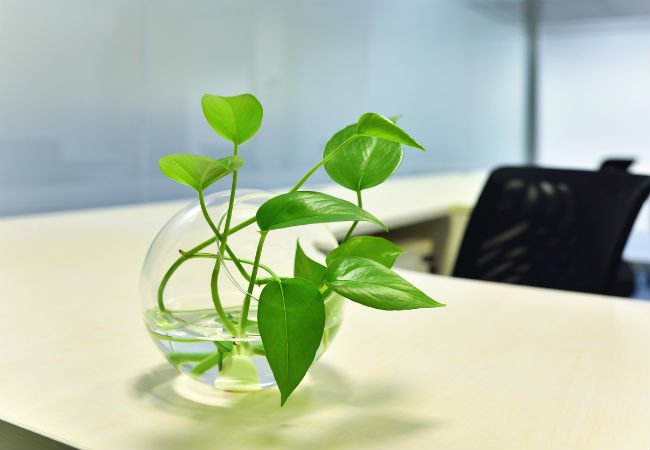
There are several basic types of hydroponic systems.
If you’re wondering how to build a hydroponic garden, you should know that there are a few different systems out there. The following basic hydroponic methods are used extensively in commercial systems. Crafty gardeners often copy them in creating their own DIY hydroponic systems.
• Drip hydroponics: Water is supplied to a growing medium in net pots at the surface using a drip irrigation system, then allowed to drain out the bottom of the pots. The bottoms of the net pots sit in a closed container so plant roots don’t dry out too quickly.
• Flood-and-drain hydroponics: Water circulates below the net pots but does not come into contact with them. Instead, wicks made from an absorbent material will soak up the water, transferring it upward to moisten the roots of the plants inside the netting. When it’s time to water, the water is pumped through the container beneath the wicks just long enough for them to become saturated. Then, the water drains into a reservoir for reuse in subsequent watering sessions.
• Water culture hydroponics: The roots of the plants are partially subjected to water on a continuous basis. In this system, the bottoms of the net pots rest just above the level of the water and a pump creates bubbles that make contact with the net pots, keeping the growing medium and roots moist.
• Aeroponic hydroponics: Similar to water culture hydroponics, an aeroponic system wets the bottom of the net pots directly, but instead of bubbling water, the roots and growing medium are moistened through the use of a misting system located in the container below the plants.
• Passive hydroponics: With passive methods, there are no pumps to circulate water. In the Kratky method, gardeners fill a container with a precalculated amount of water and nutrients and submerge the net cup so the roots can get oxygen.
RELATED: The Best AeroGarden to Bring Your Garden Indoors
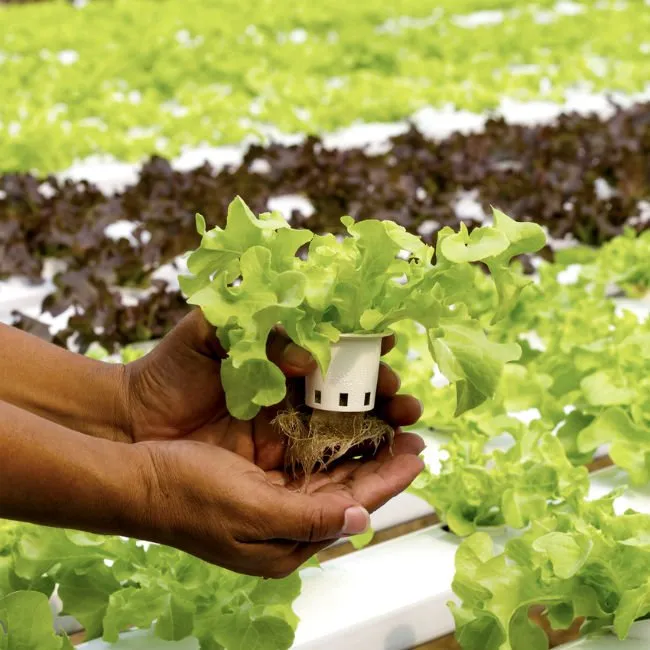
Hydroponic houseplants are trending.
Why deal with soil for indoor plants that can grow just as well (or better) in water? Many busy plant parents are opting for hydroponics to grow their indoor plants to save space and mess. Aside from herbs and leafy greens, you can grow many attractive houseplants right from cuttings. Your plants also are less susceptible to soil-borne diseases and can grow more quickly if you supply the hydroponic food they need.
Avoid heavily vining plants, and always check to make sure your water-based method will work. Some common houseplants that do well in an indoor hydroponic garden are:
- Peace lily (Spathiphyllum), an easy-care, low-light houseplant with big glossy leaves and attractive white flowers.
- Chinese money plant (Pilea peperomioides), a unique plant with round, coin-size leaves.
- Spider plant (Chlorophytum comosum), a popular plant for beginners with arching, thin leaves.
- Philodendron, a large genus of houseplants grown for their foliage, including variegated varieties.
- Geranium (Pelargonium), a favorite outdoor and indoor plant prized for its pretty flower clusters rising from round leaves.
Although it’s fun to grow these houseplants in clear glass to see the roots, they will fare better if you transfer them to an opaque container to keep light off the water (and the algae and bacteria light can feed).
Hydroponic plants grow faster than plants grown in soil.
If you’ve ever had an outdoor garden, you’ll immediately recognize some of the following benefits of growing plants in a hydroponic system:
• No hoeing or weed-picking necessary.
• No need to use pesticides to eliminate crawling insects that eat your plants.
• Plants grow more quickly because their roots don’t have to push through compact soil.
• Plant roots absorb nutrients more quickly from water than they do from soil.
• You can access fresh herbs, fruits, and vegetables any time of year.
• Hydroponic plants are not subject to soil-borne diseases.
• The system can be set up indoors or outdoors.
• Achieve high-yield production in a small space.
• While there are commercial kits available, it’s entirely possible to DIY hydroponics at home.
Many indoor hydroponic garden starter kits have everything you need to start growing right away.
You can find a wide variety of commercial hydroponic systems on the market, but they’re usually a bit on the pricey side. A snazzy-looking self-contained unit with room to grow six to 12 plants, complete with grow lights, a timer, and Wi-Fi capability to notify you via your smartphone when it’s time to add nutrients, runs $125 to $350. These indoor hydroponics units are attractive on the kitchen countertop and will produce fresh herbs year-round without the need for window lighting.
RELATED: The Best Self-Watering Planters for Low-Maintenance Gardens, Tested
If you’re into large-scale gardening, you can find commercial hydroponic systems designed to accommodate dozens—or hundreds—of plants. These units contain everything you need; lighting, pumps, tubes, and containers. They start around $1,000 and go up from there. If you want to grow and sell your produce at farmers’ markets or to local grocers, a large commercial unit can be a good investment.
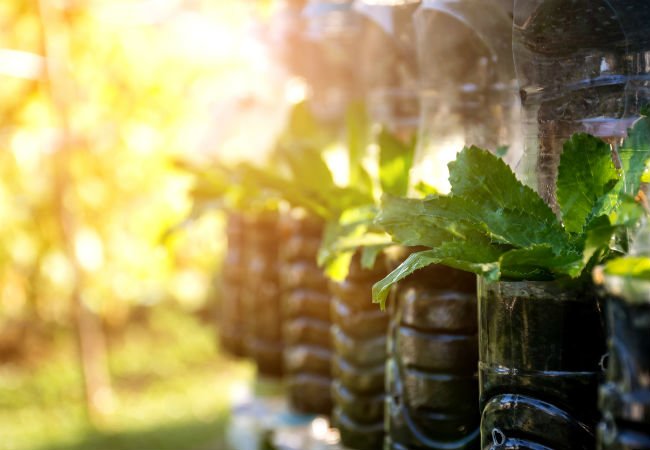
Building your own DIY hydroponic system requires more time up front that pays off later.
Don’t be intimidated! Building your own homemade hydroponic system isn’t as hard as it sounds. There are dozens of free hydroponic plans for DIYers just like you available across the internet, and you can even design your own system once you master the basics.
Depending on the size and complexity of your project, you could spend $2 to $200, or more, on materials and supplies for your DIY hydroponic system. Some of the more popular DIY hydroponics projects include:
• Restructuring an empty plastic bottle as an individual planter. Cut the top quarter off a 2-liter soda bottle, fill the bottom part with water, and then place the top part upside down in the bottom part to use as a growing pot. This inexpensive unit features a piece of natural fiber rope, such as jute, inserted through the cap into the water below to act as a wick to draw water upward and keep the growing medium moist.
• Making use of polyvinyl chloride (PVC) pipe, sometimes in elaborate configurations. These PVC hydroponic systems carry nutrient-rich water to the bottoms of individual net pots, which are inserted in holes drilled in the topside of the pipes. Water is pumped through the pipes by a submersible pump located in a large container of water to which nutrients have been added.
• Repurposing a large container so that its basin holds water. Reservoir systems can make use of a 5-gallon plastic bucket or another large plastic container with holes drilled into the lid to insert net pots and plants while water fills the bottom.
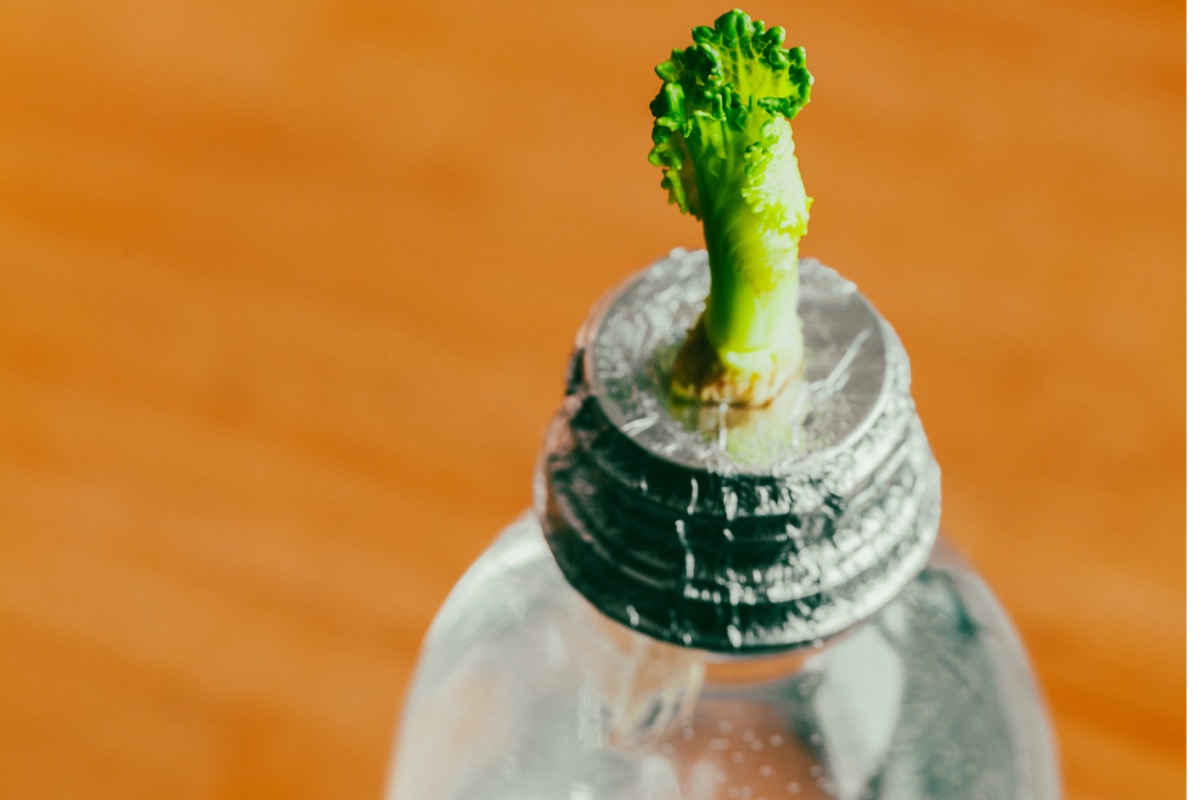
You can flood your hydroponic system with too much water.
Water is essential to all hydroponic systems, but more isn’t always better. Use the following tips that will help you grow healthy plants:
• Provide enough water to moisten the roots of the plants, but not so much that they’re consistently sopping wet.
• Keep the water moving, either by the use of a pump, sprayers, or a drip irrigation system.
• Use filtered water in your hydroponic system. Tap water contains chemicals and pathogens that can negatively affect your plants. Water from a reverse osmosis (RO) system is a good choice, but if that isn’t an option, filter tap water through a portable water filter.
• Use a bubble system, such as those found in fish tanks, to infuse the water with oxygen, which is necessary for healthy plant growth.
Hydroponic plant food is most effective when light, pH, and temperature conditions are controlled.
Plants grown in water do not get natural microbes and nutrients from the soil, and they rely on the gardener adding the nutrition they need to the water. But that can be a good thing when you grow hydroponically, because you can more easily measure and control the nutrients you add to the water. Here are some tips on caring for and feeding your hydroponic plants.
• Use supplemental lighting if natural sunlight is unavailable. You can purchase commercial grow lights or fluorescent lights to supply the additional light your plants need to grow.
• Maintain a consistent water temperature between 65 degrees Fahrenheit and 75 degrees Fahrenheit. Colder water can slow plant growth, and warmer water is at risk of developing fungi and algae.
• Use a pH tester to ensure that the water in the reservoir is not too acidic or too alkaline. Most plants require a pH between 5.7 and 6.3 for healthy, vigorous growth. When an imbalance occurs, add an acidic- or alkaline-correcting product to bring the water back into balance.
• Apply nutrients and fertilizers or hydroponic plant food to the water reservoir as recommended by the manufacturer of the fertilizers you’re using. Just be sure the product is meant for hydroponic growing. Your plants likely will need the macronutrients (nitrogen, phosphorus, and potassium, or NPK), plus calcium sulfate and magnesium. They can benefit from other macronutrients and micronutrients.
To ensure your plants get the nutrients they need, look for liquid fertilizers or water-soluble powders meant for indoor hydroponics.
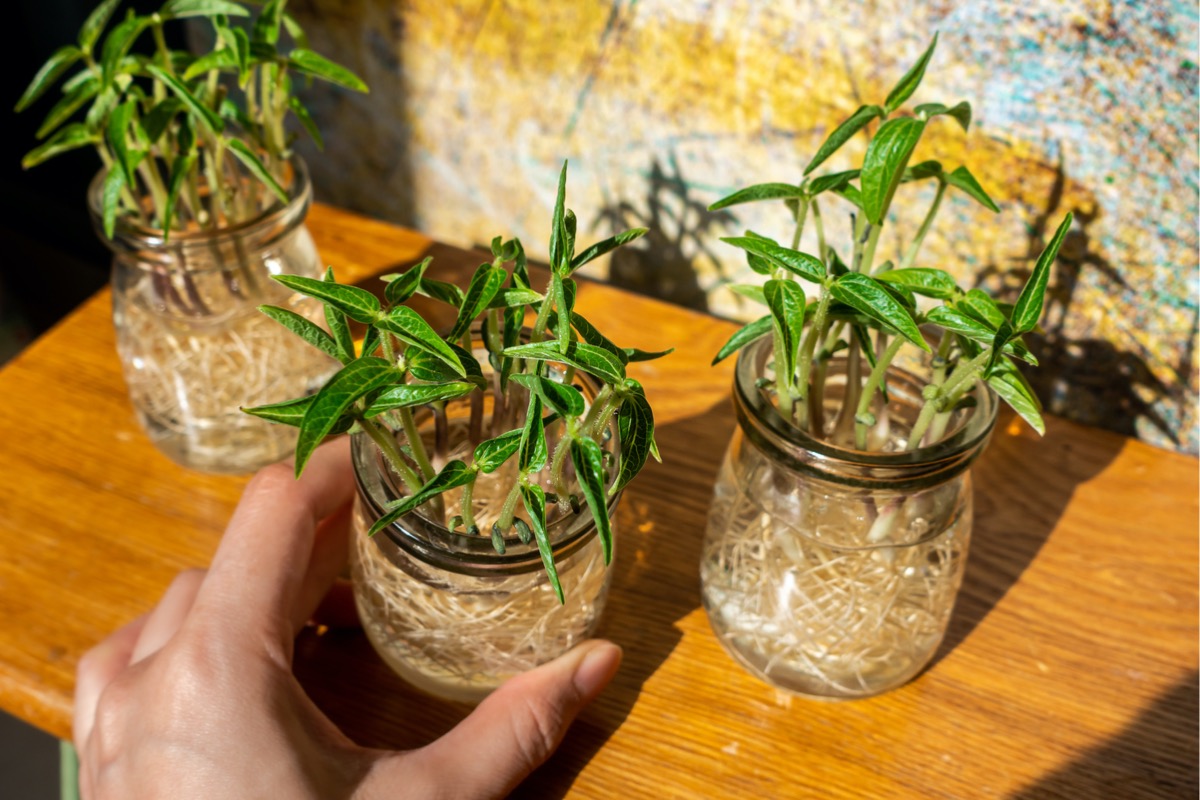
Final Thoughts
Grow healthy houseplants or edibles easily with a DIY hydroponic garden or by purchasing one of the best hydroponic systems, like those in our buyer’s guide. This tried-and-true growing method has been around for a few thousand years, and it is still popular today. Your DIY hydroponic system needs only water, light, an inert growing medium, and hydroponic plant food.
Often, you can find an indoor hydroponic garden starter kit to help set up your system, along with parts for the various types of hydroponic growing. With a little effort, your plants will grow more quickly and with less chance for most diseases in a hydroponic system.
FAQs About DIY Hydroponics
You’ll likely have a few questions when you set up a homemade hydroponic system. Here are answers to a few common questions about growing hydroponic houseplants or edibles.
Depending on the size and complexity of your project, you could spend $2 to $200, or more, on materials and supplies for your DIY hydroponic system. The more plants you grow, or the larger your garden, the more lights and containers you will need. If you already have a source of reverse osmosis water, ongoing costs are low, with no need to replace soil. You will need to provide hydroponic plant food regularly.
Growing a regular outdoor garden with soil might cost less in the long run than a hydroponic setup. That’s because you will need some special materials or containers and plenty of artificial light (plus the electricity to power pumps and lights). However, if you plan to build raised beds and purchase soil for your outdoor garden, those costs also add up. Save some money by building a DIY hydroponic system instead of purchasing one.
Once set up, most of the cost comes in the form of plant food, which will run a little more for hydroponics than for conventional growing. However, plants grow more quickly, so many farmers in particular are opting for hydroponic methods, and the larger the operation, the more the price of hydroponics comes down. Plus, factor in that it actually takes more water to grow plants in soil than hydroponically.
Aside from cost, hydroponic gardening can take a little more time and attention than conventional gardening. Since you must supply all nutrition to the hydroponic plants, you have to be pretty consistent and vigilant. Some plants just grow better in soil, so it’s a good idea to do your research first.
Since the lights and water circulation for a hydroponic system rely on electricity, a power outage can lead to lost plants. Although plants are less likely to get soil-borne diseases, they can still get waterborne disease. When they do, the problem can spread before you have time to address it because of the rapid growth of plants grown hydroponically.
